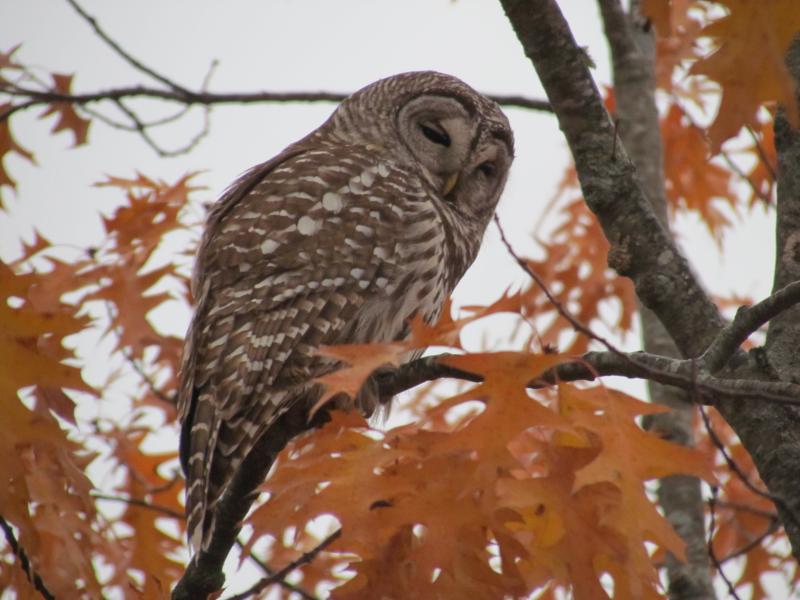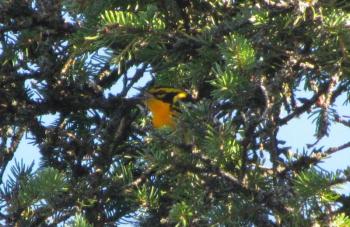Forests are incredibly important for birds.
Most of us probably know that intuitively.
Common species like chickadees, nuthatches, and woodpeckers that visit our backyard bird feeders, even those surrounded by lawns and gardens, will not occur without forest nearby. And we know that there is a long list of species of birds that we can only see in the forest — everything from barred owls to ruffed grouse to black-and-white warblers to scarlet tanagers and dozens more.
One ecological study found that there were about twice as many bird species nesting in an eastern deciduous forest as compared to a nearby salt marsh.
Have you ever stopped to think about what makes forests so good for birds?
One major part of the answer is related to the fact that forests are by definition made up of stands of trees. In older forests, the trees tend to grow relatively high (sometimes really high). Below the tallest trees lie a variety of other smaller trees and shrubs. Near the ground grow various flowering plants, grasses, sedges, and mosses. The tree cover may be interspersed with wetlands. Maybe there are openings in the forest, and different ages of trees and changes in topography that affect which trees and other plants occur in a particular spot. All of this provides different foods and places to build nests, a range of perches, and everything else a bird needs to survive and raise a family. Each bird species will use these forest features different ways.
Take a classic red oak and white pine forest that is typical in our area. In summer you may find dazzling scarlet tanagers that seem to glow while singing from the upper canopy of the oaks. Just below the canopy sitting on a snag and flying out to catch insects, you may see an eastern wood-pewee. Over in one of the white pine trees you may hear the liquid trill of a pine warbler. Down near the ground, perhaps you notice ovenbird loudly declaring “teach-er, teach-er, teach-er.” Climbing down the sturdy trunk of the oak, maybe there’s a white-breasted nuthatch calling in its upside-down pose. You may catch a glimpse of the rusty-tail of a hermit thrush that may have been startled from a tangle of low-growing shrubs, where it was searching for insects in the leaves as you walked through the forest.
In a spruce-fir forest like we see on many of Maine’s coastal peninsulas, the bird species will be completely different. The flame-orange throated blackburnian warbler and black-throated green warblers are not commonly seen much lower than mid-height of those spruces no matter how long we watch. A magnolia warbler, on the other hand, will rarely go up that high and will mostly stay in the mid to lower reaches of the balsam firs. Hopping among the moss and rocks on the shady forest floor, you might see dark-eyed juncos. Hitching inconspicuously up the tree trunks, you might see a brown creeper probing its thin, downcurved bill under the bark in search of insects and spiders.
Each species has its own place within the forest community.
Forests dominate landscapes in some parts of the world, like Maine. That’s why Maine is estimated to support 2.9 million nesting red-eyed vireos, a species that occurs only in deciduous and mixed forests.
But even here in Maine, forests are being lost, degraded, and impacted in many different ways. The U.S. Forest Service estimated that 869,000 acres of former forest land in Maine was converted by suburban and urban development between 1980 and 2000. Southern and midcoast Maine is among the hardest hit, and this trend is expected to continue into the future. Many of us can remember areas that used to be forest but have been lost even in recent decades. Forests are also experiencing lots of other stresses—invasive diseases and insects, and the rigors of a changing climate.
To ensure that forests continue to be places that host millions of birds to raise their young, we need to ensure that we protect the largest blocks of remaining forest in our area including by supporting groups like the Boothbay Region Land Trust, whose efforts are supported by members and state initiatives to fund land conservation like the Land for Maine’s Future program (LMF), and the Natural Resources Council of Maine, which advocates for LMF funding but also fends off attempted conservation rollbacks such as attacks on Maine’s treasured Public Reserved Lands that protect thousands of acres of forest. In places where forests are already lost or degraded, we may have to look at ways to restore them. And forests that have been designated for use by the forest industry need to be managed in ways that make them as friendly as possible to birds and other wildlife while ensuring that they are helping maintain clean air and water for generations to come.
Jeffrey V. Wells, Ph.D., is a Fellow of the Cornell Lab of Ornithology and Vice President of Boreal Conservation for National Audubon. Dr. Wells is one of the nation's leading bird experts and conservation biologists and author of the “Birder’s Conservation Handbook.” His grandfather, the late John Chase, was a columnist for the Boothbay Register for many years. Allison Childs Wells, formerly of the Cornell Lab of Ornithology, is a senior director at the Natural Resources Council of Maine, a nonprofit membership organization working statewide to protect the nature of Maine. Both are widely published natural history writers and are the authors of the popular books, “Maine’s Favorite Birds” (Tilbury House) and “Birds of Aruba, Bonaire, and Curaçao: A Site and Field Guide,” (Cornell University Press).
































